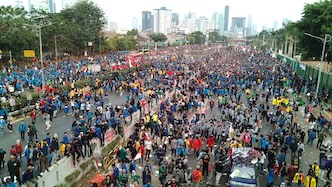The abduction of Mahmoud Khalil is among the most shocking acts of state violence in recent times, a brazen collusion between a world-renowned university and a dictatorial government that may be a harbinger of things to come.
I will have more on the issue in the coming weeks, but for now I wanted to write briefly about the nature of media coverage in the last couple of months, and the ways in which we are persuaded to believe that protests only happen in large, dense urban areas.
Of course, it is beyond heartening to see the scale of resistance towards such blatant acts of repression. In New York, Chicago, and Berkley, people have been flooding the streets, as they should.
Media outlets have been covering similar protests against Trump’s policies from the beginning of the year, but if an alien showed up today, they might be forgiven for thinking that only people in larger cities were outraged and angry. And yet, people are clearly angry about issues in Idaho, where people rallied against a school choice bill and Trump policies. In Kansas, people have been gathering to voice their support for human rights. Abortions rights protests have been going on for decades, often in states and cities overlooked by mainstream media. Abortion is becoming harder to access even in larger cities, and women in places farther away are finding it nearly impossible to do so.
Yet, if you believed mainstream media, people are really only protesting in the well-known cities. A lot of this has to do with the fact that reporting is expensive, something most readers cannot seem to grasp as they insist that “information should be free.” A journalist’s job is not the same as that of an at-home Substacker or blogger, and being on the frontlines requires money for lodging and food, along with professional equipment (go ahead, try recording that event with your phone camera). Everywhere, local media outlets have faced massive cuts and often simply disappeared, which means that the public increasingly depends on larger outlets like the New York Times with their focus on specific geographical areas. Publications often have to depend on critical analysis, not actual reporting, because so much of their funding has to go towards keeping the lights on.
What does all of this mean? The more we see coverage of protests only in large urban areas, the more the public is persuaded that, perhaps, matters like the disappearance of a dissident don’t really matter anywhere else. But they do, very much. It also matters that we undersand that protests are not only for and by privileged elites in large metropolitan areas, but that they involve people everywhere and from all walks of life.
Journalism is harder and more expensive than ever before, but if things are to change (and not just four years at a time), both the public and media have to start acknowledging that resistance happens everywhere, and in numbers large and small.
See also: “Support Your Media, or Watch It Die.”
Here is how to support my work.
Image: By JahlilMA, Wikipedia

Don’t plagiarise any of this, in any way. I have used legal resources to punish and prevent plagiarism, and I am ruthless and persistent. I make a point of citing people and publications all the time: it’s not that hard to mention me in your work, and to refuse to do so and simply assimilate my work is plagiarism. You don’t have to agree with me to cite me properly; be an ethical grownup, and don’t make excuses for your plagiarism. Read and memorise “On Plagiarism.” There’s more forthcoming, as I point out in “The Plagiarism Papers.” If you’d like to support me, please donate and/or subscribe, or get me something from my wish list. Thank you.

